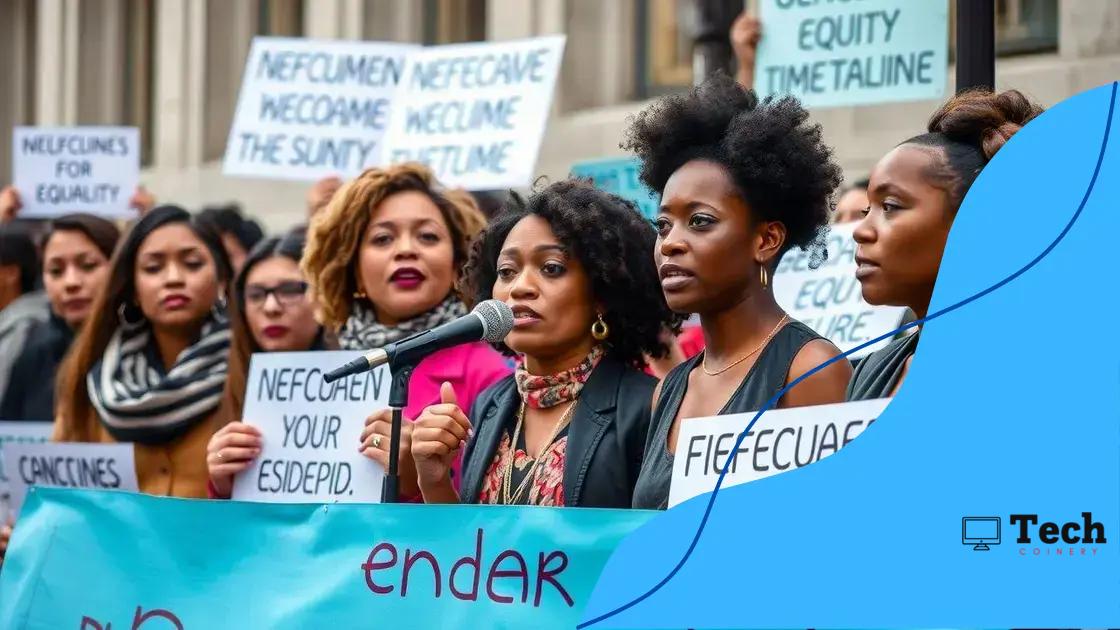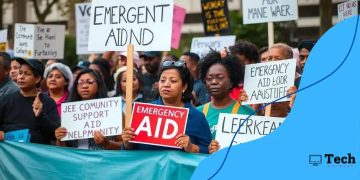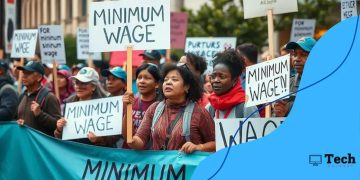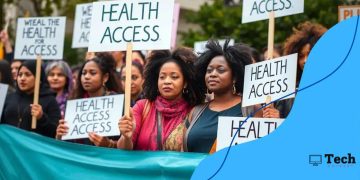Gender equity protest movements: a call to action

Gender equity protest movements aim to achieve equal rights and opportunities for all genders, influencing policies, raising awareness, and advocating for social change through activism and education.
Gender equity protest movements have been pivotal in shaping societal attitudes towards equality. These movements not only aim for justice but inspire generations to stand up for their rights. Curious about their journey? Keep reading.
Understanding gender equity
Understanding gender equity is crucial for fostering an inclusive society. It’s about ensuring that everyone, regardless of their gender, has equal rights and opportunities. This includes access to resources, decision-making, and fundamental human rights.
What is Gender Equity?
Gender equity refers to the fair treatment of all genders, providing equal access to opportunities and resources. Unlike equality, which focuses on treating everyone the same, equity allows for different needs to be met. For example, women might need additional support in the workplace to achieve the same outcomes as their male counterparts.
Key Principles of Gender Equity
- Empowerment of marginalized groups.
- Recognizing and addressing biases and inequalities.
- Creating safe and supportive environments for all.
- Encouraging collaboration and participation.
By focusing on these principles, we can work towards dismantling barriers that prevent individuals from reaching their full potential. In various sectors, from business to education, implementing gender equity practices can lead to more innovative and effective solutions.
Furthermore, gender equity also plays a significant role in social stability. When everyone has a voice, conflicts can be resolved more peacefully, and communities thrive. We can create change when we recognize the value of diverse perspectives.
Why is Gender Equity Important?
Achieving gender equity is not just a moral obligation; it brings tangible benefits to society. Countries that promote gender equity often see higher economic growth and lower levels of violence. Investing in women and marginalized genders leads to better outcomes across the board, benefiting health, education, and economic stability.
History of protest movements
The history of protest movements is rich and complex, marked by moments of courage, unity, and significant change. These movements have often emerged in response to social injustices and inequalities, driving communities to fight for their rights and dignity.
Early Movements
From the suffragette movement in the early 20th century to civil rights struggles, early protest movements laid the foundation for modern activism. They challenged the status quo and fought for fundamental rights, often at great personal risk. Such actions were crucial in advancing gender equity, as they highlighted the disparities women faced.
Major Milestones
- The Civil Rights Movement in the 1960s, advocating for racial equality.
- The Women’s Liberation Movement, which focused on achieving gender equality.
- The Stonewall Riots of 1969, a pivotal moment for LGBTQ+ rights.
- The Global Climate Strikes, highlighting environmental justice.
These milestones reflect how protest movements have evolved, responding to new challenges and advocating for a broader range of issues. Each movement has contributed to our understanding of rights and equity in unique ways.
Fast forward to today, numerous protest movements continue to address contemporary issues such as climate change, systemic racism, and gender inequality. The rise of social media has transformed how these movements organize and spread their messages, allowing for a more decentralized approach.
Impact of Protest Movements
The impact of these movements cannot be overstated. They have led to significant policy changes and societal shifts. For example, the push for gender equity has resulted in legislative changes around pay equity, workplace rights, and representation in leadership roles. Activists not only drive these changes but also inspire future generations to continue the fight.
Key figures in gender equity protests

Key figures in the gender equity protests have significantly shaped the landscape of activism. These leaders have brought attention to pressing inequalities and inspired countless individuals to take action.
Notable Activists
Many activists rose to prominence for their unwavering commitment to fighting for gender equity. Some of the most notable include:
- Gloria Steinem – A prominent feminist, she has been a strong advocate for women’s rights since the 1960s.
- Malala Yousafzai – As a young activist for girls’ education, she represents the fight for equity across the globe.
- Ruth Bader Ginsburg – The late Supreme Court Justice advocated for gender equality in the legal system, paving the way for many.
- Tarana Burke – The founder of the “Me Too” movement has highlighted the importance of addressing sexual violence.
Each of these figures has played a vital role in shaping public discourse about gender equity. Their work reminds us of the ongoing struggles and the need for continued advocacy.
Beyond individual activists, various organizations have emerged, supporting these movements. Organizations such as the National Organization for Women (NOW) and the Women’s March have mobilized thousands, bringing visibility to critical issues of gender equality and pushing for necessary reforms.
The Power of Leadership
Leadership within gender equity protests often fuels movements. Charismatic figures inspire others to join, creating a sense of community and common purpose. This collective action is vital for generating momentum and achieving change.
Collaborative efforts, like workshops, demonstrations, and online campaigns, have enabled everyday individuals to contribute to these movements. The stories of key figures not only exemplify the fight for gender equity but also highlight the importance of diverse voices being heard and acknowledged.
Impact on policy and society
The impact of gender equity protests on policy and society is profound and far-reaching. These movements have reshaped laws, influenced public opinion, and created a ripple effect that leads to lasting change.
Policy Changes
One of the most visible impacts is the creation and modification of policies that promote gender equity. For instance, many countries have enacted laws aimed at closing the gender pay gap. These laws force companies to be more transparent about salaries and work towards equal pay for equal work.
Areas Affected by Policy Changes
- Workplace Rights – New regulations ensure fair treatment and better opportunities for women in the workplace.
- Reproductive Rights – Advocacy has led to improved access to healthcare services for women.
- Educational Equity – Policies now focus on ensuring that girls have equal opportunities in education.
- Anti-Discrimination Laws – Many nations have strengthened laws against gender-based discrimination.
These changes demonstrate how effective protest movements are in holding governments accountable. Activists continuously work to push for legislative reforms that reflect the needs of society and promote equality.
Moreover, the societal impact of gender equity protests cannot be underestimated. They raise awareness about the importance of equality, encouraging conversations around gender issues in various spaces like homes, schools, and workplaces. This shift in consciousness fosters a more informed and compassionate society.
Changing Perspectives
While policy changes are vital, the transformation of societal attitudes towards gender equity is just as crucial. As individuals become more aware of gender issues, they are more likely to stand against discrimination and support equitable practices. This cultural shift plays a significant role in preventing inequality and promoting a balanced society.
Future of gender equity movements
The future of gender equity movements looks promising but also faces significant challenges. As society evolves, these movements will continue to adapt and grow, responding to new issues and advocating for lasting change.
Emerging Issues
As awareness of gender equity expands, new topics are coming to the forefront. For example, the rise of technology has highlighted issues like online harassment and digital privacy. Movements will need to address these emerging threats while pushing for greater equity in technology and business.
Future Focus Areas
- Intersectionality – Addressing how different identities (race, sexuality, class) affect individuals’ experiences of inequality.
- Men’s Role – Engaging men as allies in the struggle for gender equity and involving them in discussions about toxic masculinity.
- Health Access – Advocating for equitable access to healthcare services for all genders.
- Sustainable Development – Linking gender equity to environmental justice and sustainable practices.
These focus areas are essential for adapting to the changing landscape of social justice and ensuring that all voices are included in the conversation. The involvement of a diverse range of individuals will strengthen the movements.
Technology will also play a vital role in the future of gender equity movements. Social media platforms enable activists to reach larger audiences and mobilize action more quickly. Online campaigns can generate awareness and increase support for initiatives aimed at protecting women’s rights and promoting equity.
The Role of Education
Education will be critical in shaping the future of these movements. Teaching young people about gender equity and the importance of diversity can foster an environment where equality is valued. Schools can use programs that promote discussion about gender roles, diversity, and respect.
FAQ – Frequently Asked Questions about Gender Equity Movements
What are gender equity movements?
Gender equity movements are social movements aimed at achieving equal rights, opportunities, and treatment for all genders, addressing issues like pay inequality and discrimination.
How do these movements impact policy?
They influence policy by advocating for laws that promote gender equality, such as equal pay legislation and workplace protections.
What role does education play in these movements?
Education fosters awareness and understanding of gender issues among youth, helping to create a more equitable society in the future.
How can technology support gender equity movements?
Technology enhances activism by facilitating communication, spreading awareness through social media, and mobilizing supporters for causes.






